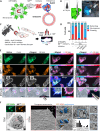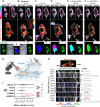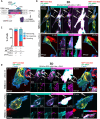Live-cell magnetic manipulation of recycling endosomes reveals their direct effect on actin protrusions to promote invasive migration
- PMID: 40614209
- PMCID: PMC12227070
- DOI: 10.1126/sciadv.adu6361
Live-cell magnetic manipulation of recycling endosomes reveals their direct effect on actin protrusions to promote invasive migration
Abstract
Endocytic recycling pathways play key roles in a broad range of cellular processes, and many vesicle trafficking regulators are implicated in progression of disease such as cancer. The Rab11 family (Rab11a, Rab11b, and Rab25) controls the return of internalized cargos to the plasma membrane, and Rab25 has been implicated in the aggressiveness of cancer by promoting invasive migration. However, while Rab25 vesicles distribute to the leading edge of moving cells, how directly they contribute to cell protrusion is not clear. Here, we adopt a magnetogenetic approach that allows direct manipulation of Rab25 positioning to show that localization to the cell periphery drives the formation of F-actin protrusions. We demonstrate that endogenous Rab25 vesicles coordinate the positioning of key cargos, including the actin regulator FMNL1 and integrin β1, with the activation of Rho guanosine triphosphatases at the plasma membrane to generate and maintain F-actin-rich filopodium-like protrusions and promote cancer cell invasive migration in the three-dimensional matrix.
Figures






Similar articles
-
HIV-1 Nef Antagonizes SERINC5 Restriction by Downregulation of SERINC5 via the Endosome/Lysosome System.J Virol. 2018 May 14;92(11):e00196-18. doi: 10.1128/JVI.00196-18. Print 2018 Jun 1. J Virol. 2018. PMID: 29514909 Free PMC article.
-
CIN85 and CD2AP Are Novel Constituents of Dynamic Tubular Recycling Endosomes That Regulate Recycling Upon Recruitment by MICAL-L1.Traffic. 2025 Jul-Sep;26(7-9):e70015. doi: 10.1111/tra.70015. Traffic. 2025. PMID: 40740057 Free PMC article.
-
The kinesin KIF3AC recycles endocytosed integrin to polarize new adhesion formation toward the leading edge.Proc Natl Acad Sci U S A. 2025 Jul 29;122(30):e2513776122. doi: 10.1073/pnas.2513776122. Epub 2025 Jul 24. Proc Natl Acad Sci U S A. 2025. PMID: 40705420
-
Signs and symptoms to determine if a patient presenting in primary care or hospital outpatient settings has COVID-19.Cochrane Database Syst Rev. 2022 May 20;5(5):CD013665. doi: 10.1002/14651858.CD013665.pub3. Cochrane Database Syst Rev. 2022. PMID: 35593186 Free PMC article.
-
Interventions for providers to promote a patient-centred approach in clinical consultations.Cochrane Database Syst Rev. 2012 Dec 12;12(12):CD003267. doi: 10.1002/14651858.CD003267.pub2. Cochrane Database Syst Rev. 2012. PMID: 23235595 Free PMC article.
Cited by
-
Time, the final frontier.Mol Oncol. 2025 Aug;19(8):2157-2162. doi: 10.1002/1878-0261.70025. Epub 2025 Mar 24. Mol Oncol. 2025. PMID: 40126098 Free PMC article.
-
The unique contributions of Rab11 and Rab35 to the completion of cell division.Biol Res. 2025 Aug 29;58(1):59. doi: 10.1186/s40659-025-00638-x. Biol Res. 2025. PMID: 40877912 Free PMC article.
References
-
- Scita G., Di Fiore P. P., The endocytic matrix. Nature 463, 464–473 (2010). - PubMed
-
- Golachowska M. R., Hoekstra D., van IJzendoorn S. C. D., Recycling endosomes in apical plasma membrane domain formation and epithelial cell polarity. Trends Cell Biol. 20, 618–626 (2010). - PubMed
-
- Kelly E. E., Horgan C. P., McCaffrey M. W., Rab11 proteins in health and disease. Biochem. Soc. Trans. 40, 1360–1367 (2012). - PubMed
MeSH terms
Substances
LinkOut - more resources
Full Text Sources

